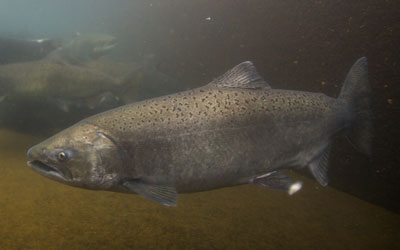Fall run salmon are returning to the upper Klamath Basin, with fisheries biologists from Oregon Department of Fish & Wildlife (ODFW) and The Klamath Tribes finding salmon in areas where they have been absent for over a century.
There have been numerous sightings of salmon migrating into the upper basin during the 2025 fall season. A Chinook salmon was spotted passing Keno Dam on Sept. 24. On October 6, another salmon was seen on camera at the Link River fish ladder.
By the second week in October, a radio-tagged salmon was detected in the Williamson River along with multiple other salmon. On October 14, tagged fish were found in tributaries on the west side of Upper Klamath Lake (Pelican Bay) and in the Sprague River.
To monitor Klamath River salmon, biologists are using tools like monitoring cameras and radio tags to track the salmon’s journey.
“The run so far this year has been incredibly exciting and we’re expanding our monitoring program on an almost daily basis to keep adapting,” said Mark Hereford, ODFW Klamath fisheries reintroduction project leader. “It is incredible to be a part of this historic return and see where these salmon go and what they do.”
Beyond passing dams, salmon are navigating through the Keno reach and Upper Klamath Lake. Biologists have been unsure how quickly salmon would navigate the less favorable conditions in upper Klamath Lake and above Keno Dam prior to reaching the abundant spawning habitat in the Williamson River and elsewhere.
For the 2025 season, salmon have exceeded expectations and are spreading throughout the basin. The scenario playing out is exactly what ODFW, Tribes, and many conservation partners had been hoping for when the dams were removed.
“What we’re seeing now is incredibly encouraging and the result of strong collaboration among state and federal agencies, Tribes, and conservation partners who have all been working towards this moment for an incredibly long time,” Hereford said.
Monitoring efforts are guided by an implementation plan developed by ODFW and The Klamath Tribes in 2021 in preparation for the 2024 dam removals.
ODFW is reminding anglers that all salmon fishing remains closed in the Oregon portion of the Klamath River Basin to support salmon recovery.
Other regulations in place will help protect salmon as they return: Spencer Creek closed to fishing early this year (Sept. 30 rather than Oct. 31) to protect spawning Chinook. Other Klamath River tributaries (Williamson, Wood, Sprague) are routinely closed to all angling Nov. 1–May 21 to protect spawning redband trout and these closures will offer additional protection for returning salmon.
Klamath River Facts
The Klamath River stretches 257 miles from Lake Ewauna near Klamath Falls, Oregon, to the Pacific Ocean.
Following the removal of four hydroelectric dams in 2024 the Klamath River now flows unimpeded below the Keno Dam. The dam removals allowed migrating salmon and steelhead trout to reach miles of historical spawning grounds.
Chinook salmon (Oncorhynchus tshawytscha) are the most abundant salmon in the Klamath.
Spring-run Chinook historically migrated into upper tributaries during spring, holding in cool pools until spawning in late summer to early fall.
Fall-run Chinook migrate mainly in October, and spawn soon after arrival.
Coho salmon (Oncorhynchus kisutch) are less numerous than Chinook but ecologically important.
Cohos are listed as threatened under the Endangered Species Act in the Southern Oregon/Northern California region.
Coho salmon were first documented migrating past former dam sites in December 2024.
Klamath River steelhead trout (Oncorhynchus mykiss) migrate alongside Chinook and Coho.
sources: source: Oregon Department of Fish & Wildlife, USGS Western Fisheries Research Center

Leave a Reply
You must be logged in to post a comment.